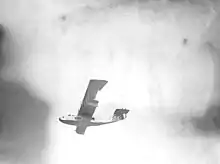American Trans-Oceanic Company
American Trans-Oceanic Company was an airline based in the United States.
| Founded | 1914 |
|---|---|
| Hubs | Port Washington, New York Palm Beach, Florida |
| Headquarters | New York City [1] |
| Key people | Rodman Wanamaker Glen Curtiss Grover Whalen |
History
Rodman Wanamaker published a letter in 1916 stating the founding of the American Trans-Oceanic Company to capitalize on the 1914 effort to fly across the Atlantic non-stop. A Curtiss H-16 aircraft was ordered for the company. Wanamaker claimed that if the trans-Atlantic flight could be accomplished once, then it could be accomplished over and over with commercial transports shortly thereafter.[2]

Forming just prior to America's full involvement in World War I, American Trans-Oceanic Company became one of the earliest commercial airlines in the United States. Operations also included a full-time flight school in Long Island and Palm Beach using Curtiss aircraft.[3] New innovations were deployed, such as a Sperry autopilot.[4] Rates varied from $15 for a 15-minute flight to $250 for a 320-mile flight to Cuba. Four five-hour flights a week were flown to Bimini at night.[5] By 1918, the company carried four to five thousand passengers without incident.[6]
The company's most distinctive aircraft was Big Fish, A Curtiss H-16 painted as a fish that flew between Palm Beach, Havana, Nassau, and New York City.[7]
In 1927, Wanamaker sponsored Richard E. Byrd through the American Trans-Oceanic Company to make the Transatlantic attempt again in a Fokker Trimotor, the America. The company put up nearly $150,000 to fund the effort.[8] The aircraft crashed on the attempt to win the Orteig Prize, losing to Charles Lindbergh. The team attempt was accomplished on July 1, 1927, crashing in Ver-sur-Mer.[9]
Wanamaker died in May 1928. Without Wanamaker's involvement, American Trans-Oceanic Company's sponsorships did not continue.
Destinations
- Country/Continent
Fleet
The American Trans-Oceanic Company fleet consists of the following aircraft as of 1918:[10]
| Aircraft | Total | Routes | Notes | |
|---|---|---|---|---|
| Curtiss Model F | Short Routes | 5-6 place open flying boats | ||
| Curtiss H-16 | Long Routes | 14-16 place flying boats |
Incidents and accidents
In January 1917, one of the Twin engine Curtiss flying boats was destroyed when it was torn from its hangar in a gale storm in Long Island.[11] In 1921 the Big Fish, Curtiss H-16 was destroyed in a crash.[12]
References
- Flying: 354. September 1916.CS1 maint: untitled periodical (link)
- Flying: 99. April 1916.CS1 maint: untitled periodical (link)
- Flying: 354. September 1916.CS1 maint: untitled periodical (link)
- "aerial age weekly". 4 December 1916. Cite journal requires
|journal=(help) - "High over Palm Beach". Archived from the original on 26 May 2012. Retrieved 3 January 2012.
- Aerospace Industries Association of America; Manufacturers Aircraft Association; Aircraft Industries Association of America; Aeronautical Chamber of Commerce of America. Aircraft year book. p. 12.
- Lynn Lasseter Drake; Richard A. Marconi. West Palm Beach: 1893 to 1950.
- Richard Bak. The Big Jump: Lindbergh and the Great Atlantic Air Race.
- Richard Evelyn Byrd; Raimund Erhard Goerler. To the Pole: the diary and notebook of Richard E. Byrd, 1925-1927.
- Aerospace Industries Association of America; Manufacturers Aircraft Association; Aircraft Industries Association of America; Aeronautical Chamber of Commerce of America. Aircraft year book. p. 12.
- The Rudder, Volume 33. p. 94.
- "High over Palm Beach". Archived from the original on 26 May 2012. Retrieved 3 January 2012.
External links
- Image of the Curtiss H-16 Big Fish
- Hotel Royal Poinciana, Palm Beach Photographs of Big Fish